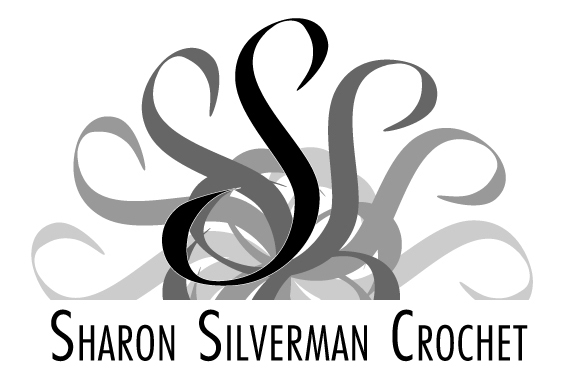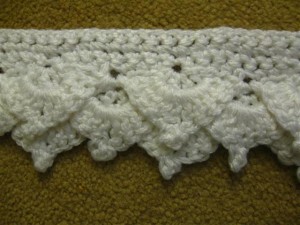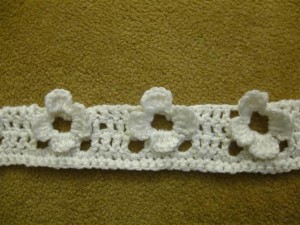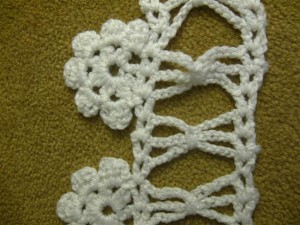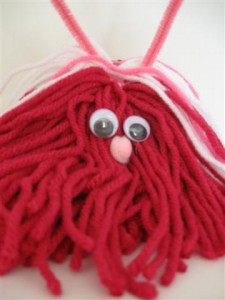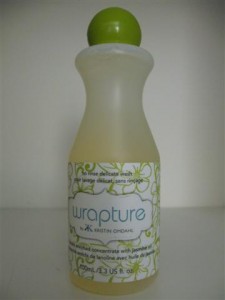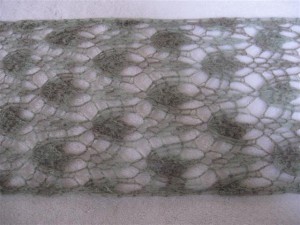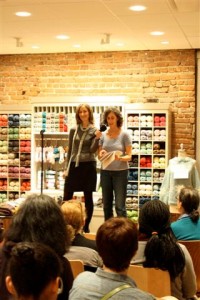I recently had the opportunity to explore Kristin Omdahl's new book, The Finer Edge: Crocheted Trims, Motifs & Borders (Interweave/F+W Media; $22.95). Full disclosure: the publisher sent me a review copy. I wondered how much could be new in edgings, considering the 150 stitch patterns in The Harmony Guides Crochet Edgings & Trims and Edie Eckman's Around the Corner Crochet Borders: 150 Colorful, Creative Edging Designs with Charts and Instructions for Turning the Corner Perfectly Every Time, among other books. I was pleasantly surprised to see 40 lovely stitch patterns and 12 garment patterns in Kristin's book. Crocheters are sure to find creative and interesting ways to finish their projects by browsing through this beautifully photographed book. Each trim comes with written instructions and a symbol chart. The edgings are grouped by construction type: first, starting with the finished item and adding the edging out from there; next, starting with the edging and working toward the finished item; third, working sideways and attaching the edging to the finished item every so often; and wrapping up with miscellaneous. I found them refreshingly not the "same old same old."
Anyone who is familiar with Kristin's work will know that she is an expert with motifs and edgings. I asked her where she got the inspiration for the edgings:
I love to design my own edging, focusing on my tropical foliage living in SW Florida for inspiration. I designed this collection for myself, to have a handy reference of my favorite edgings organized by construction style.
I put the book through its paces by making several samples of some cool-looking patterns that really appealed to me. The first is "Tiered Offset Shells in Rows" (p. 19). Here is my swatch:
Next I made the "Faux Embellished 4-petal Flowers I" (p. 41):
I had a moment of confusion, possibly semantic, on Row 3. The written instructions say to turn 90 degrees counterclockwise and work along the post of the dc just worked. (I'm assuming the instructions are for right-handers.) Although you do move your hook counterclockwise, you actually turn the work clockwise to achieve that. Fortunately, the symbol chart guided me and I was able to finish the swatch with no problem. The three-dimensional effect is very pretty. I blocked the petals on my swatch and think that it looks even better than the sample in the book!
Feeling bold, I made the "Flower-fringed Web" (p. 64), which is featured in the Palmira Shawl. I can definitely see possibilities for using this!
My final swatch was "Faux Overlapping Circle Motifs" (p. 72), featured in the Luxor Blanket. 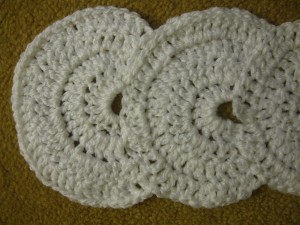
Anytime I can make motifs without having to sew them together, I'm all for it! These medallions look great and I love how they grow, one from the other. However, I was disappointed to find an error in the written instructions. For Motif 3, after you sl st in each of next 17 sts, you should Repeat Rows 1-4 of Motif 2; the written instructions say to Repeat Rows 2-4 of Motif 2. The omission in the text is obvious if you look at the symbol chart, which is correct. I asked Kristin about this and she graciously acknowledged that there is indeed an error. The mistake is repeated in the Luxor Blanket pattern, p. 105 (which makes me wonder what the testing process was for that pattern). I assume that the corrections will be published promptly.
(Note to designers, editors, and publishers: Hire me to check your patterns! I don't know if it's my background in technical writing or just my nature, but I am drawn to mistakes like a moth to a flame. If there's something wrong or missing, I'll find it. Except, probably, in my own patterns--it's always best to have another pair of eyes look things over since we all see what we expect, rather than what's there. Occupational hazard.)
Getting back to the book's content, don't miss the discussion on p. 9, "Edging Around the Corner." If you have ever had trouble conceptualizing how many extra stitches you need to make in order to keep the trim in synch with the project, this will help clear that up.
Once you have practiced making some edgings, turn to the Projects section of Kristin's book. There you'll find selected edgings incorporated into 12 colorful projects with Kristin's signature style. Like any pattern book, some designs will appeal to you more than others. Personally, I think the Petra wrap skirt is adorable! I also like the Birka Car Coat and the Luxor Blanket (though I'm not sure the latter qualifies as a "garment"). While the mesh background of the Persepolis Top is lovely, the placement of the edging doesn't do much for me: it looks too much like the Miss America sash. However, the technique of attaching trim to a mesh background like that is interesting and might be perfectly suited to another project; Kristin suggests adding it onto a skirt bottom or a triangular shawl.
There is something in this book for crocheters at all levels. It's pretty easy to tell how complicated an edging or project is just by looking, but it would have been helpful to have the skill levels listed (at least for the projects).
Kristin is an energetic person who never lacks for ideas, so I asked her which part of a project she likes best:
Idea stage is the most exciting for me. If I happen to have yarn on hand to begin immediately, that is even better.
She added that each stage of a project has its appeal. Kristin enjoys testing her ideas to see whether the math works out, seeing a project come to life, and finishing it off. The designer, a single mother who runs her own business, adds that sending out invoices so she can put food on the table and a roof over her head is rewarding as well!
I've met Kristin several times, and we have corresponded regularly since she provided designs for my book, Beyond Basic Crocheting. I have always been impressed with her ability to embrace new ventures and marketing techniques. I asked her what she is working on now. Besides book proposals, networking with colleagues, and attending conferences, Kristin is also
making videos for my YouTube Channel, designing freelance for customers, and working on social media to promote all of the above. I'm seeking out the right medium to communicate with my audience more personally. I'm not sure if it will be a video podcast, more YouTube videos (like a regularly broadcast show), or more Webinars. I want to be able to teach, talk and discuss with my audience on the web.
